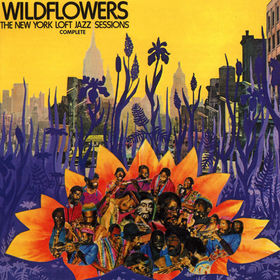Douglas originally published the 5-LP Wildflowers, The New York Loft Jazz Sessions. This album filled a void in free jazz. Impulse, the long-standing champion of labels that would risk their budgets to release free jazz artists, had abandoned what was becoming a slowly declining release program by 1975. Apart from the fledgling Black Saint label and Arista’s cautious dabbling with its Novus series, Anthony Braxton’s contract, and the handful of artist run labels still in business, free jazz was becoming an even more scarce commodity in the United States’ post Vietnam depression. The Wildflowers LPs were not only a source of cold water for the free jazz industry, but they also documented nearly all the major US-based players of that era. The set included many of the original New Yorkers from the 60s, including Sunny Murray and Marion Brown, Dave Burrell and Andrew Cyrille. There were also recent immigrants from Chicago’s AACM and St. Louis’ BAG collectives, as well as a few young players (David Murray and Ahmed Abdullah), who provided a complete overview of current music trends. The LPs were recorded as snapshots from a festival held at Sam Rivers’ loft Studio Rivbea, May 1976. They capture a kind of grassroots energy that can be considered the beginning of an artist-centered aesthetic that has grown into more frequent engagements such as the Vision Festival. The reissue of Wildflowers’ set, which was jammed onto three full CDs by Knitting Factory’s Knit Classics subsidiary, is a valuable return to the market for non-collectors. The music’s notable changes are evident from the opening track, “Jays”, on the first disc. Kalaparusha (Maurice McIntyre), gets his tenor mojo going over an electric bass-driven groove. As has been discussed in other assessments of this collection, “free jazz” was beginning to incorporate the more palatable elements of its otherwise sworn enemy “jazz fusion” with distinctive results–Kalaparusha’s track being a prime illustration of that hybridity. The rest of the disc contains more traditional expressions of the art form, with different degrees of structure. Ken McIntyre’s wily alto navigates the angles of his “New Times”, while Sunny Murray’s untouchable factor group (w/Byard Lancaster, David Murray, Khan Jamal, and Fred Hopkins) explores “Over the Rainbow” using Lancaster’s beautiful vibrato. Continuing the theme, Sam Rivers’ “Rainbows” is one of his finest recordings–capturing the saxophonist blowing his trademark soprano streams over a highly sympathetic rhythm section. The disc’s other highlights include tracks by Air (“USO Dance”, that exemplifies the combination sensitivity and fire which made them one the best jazz trios in the decade), Flight to Sanity (“The Need to Smile”), a beautifully organic Afro-modal affair where Sonelius Smith’s keyboard joins the dynamic percussionists Harold Smith and Don Moye to create bluesy communion), and Marion Brown’s solo alto performance “And Then They Danced”, in which his combination of lyrics and rough edges and lyrics enhance the song’s inherent sweetness. The second disc continues the debate between structuralists and fusion-tinged, free-blowing pieces. They occupy a large portion of the disc. Leo Smith’s chamber-like obsesity and New Delta Ahkri’s “Locomotif No. 6” are examples of this. The chamber-like obtusity of Leo Smith and New Delta Ahkri’s “Locomotif No. 6”, the stiff flamenco/folk convolutions of Michael Jackson “Clarity 2”, Hamiet Bluiett “Tranquil Beauty”, and the sweet layers and sugary resolutions of Julius Hemphill “Pensive” all suffers from tight compositional strictures that even dwarfs the moments for brilliant playing (like Bluiet’sy and guitarist Bern Nix’solololololooloololodic runs on the Hemphill). Ahmed Abdullah’s Blue Phase is the disc’s fusion experiment. It successfully blends electric and acoustic basses in a murky, bottom end. However, it loses out to Mashujaa’s heavily effected, wet guitar. (Interestingly, however, his tone is very similar to the phase-shifted sound that reggae guitarists used to use). The disc’s lone representative of freer boundaries, Andrew Cyrille and Maono’s rather directionless “Short Short,” is also a disappointment–though that may have more to do with the excerpter’s scalpel than the musicians themselves. It also has a lot of research gone wrong, such as Oliver Lake’s “Zaki”, which is impeded by Michael Jackson’s bizarrely synthesized guitar and Roscoe Mitchell’s “Chant”, which is a marathon circular breathing exercise that walks the fine line between annoying and exhilarating. However, the third disc contains a few of the best selections in the collection. Jimmy Lyons’ “Push Pull”, a combination of angular alto strokes and minimal percussion, creates a complex, yet intuitive wonder. It features Karen Borca’s rich, wooden bassoon. Sunny Murray and the Untouchable Factor return for the 17-minute “Something’s cooking” disc. This is perhaps the highlight of the set. The mood begins as a delicate web supported by Murray’s cymbal whispers. It expands through the otherworldly plateaus spun kinetically by Jamal’s vibes and an alto/tenor dialogue between Murray, Lancaster. Only to end on the spiritual edge when Hopkins’ bowed levitations meet Lancaster’s primordial flute. Beyond all of this music–which, even with the few unsuccessful pieces adds up to nothing less than essential–adding to the collection’s value is the set’s booklet with archival photographs, poster reproductions and critic Howard Mandel’s historical/contextual essay on the loft scene and its greater significance. These sessions are essential for any free jazz listener. They document a period of music history that has been neglected until now. from http://www.onefinalnote.com
